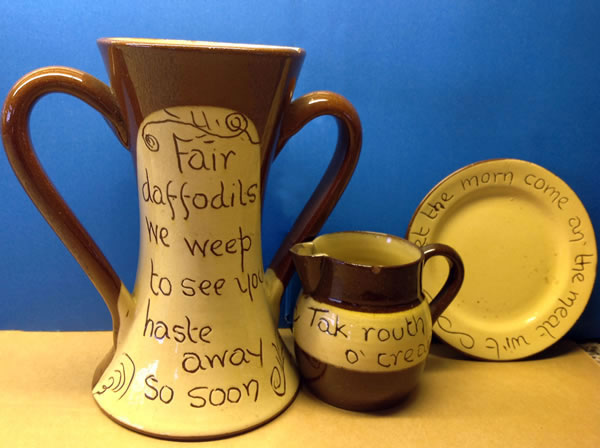Cumnock Pottery
This is a brief account of the Cumnock Pottery which was in existence for a total of 128 years from 1792 until around 1920. The famous Motto Ware was not produced until about 1830 – when requests were often made for pots inscribed for a particular occasion like a wedding or a christening. These would generally be inscribed with a name and often a favourite quotation in Scots.

Like the current motto calendars or diaries with their witty sayings or wise words – many Scottish homes had a least one item of “Scottish Motto Ware”. Jam pots, sugar bowls, salt crocks, teapots and vases were all produced in a red-brown and cream finish adorned with mottoes like:-
- “Dooble drinks are aye guid for drouth”
- “Tak a cup o’ kindness for Auld Lang Syne”
- “Ye’re unco welcome”
- “Oatmeal grains mak Scotsmens brains”
Other items of pottery were inscribed with the addresses of the clients – eg Thomas Douglas, Commercial Hotel, Lochmaben (large drinks jug) or Mrs R. Wilcox, New Prestwick, 1898 (teapot). Cumnock Pottery had a market throughout the UK in the late 19th and early 20th centuries.
Origins of the Pottery
Work began at the Greenbraehead (off Glaisnock Street) site of the Cumnock Pottery in 1792 but as already noted the motto ware was produced much later. In fact the Pottery was initially set up to produce graphite crucibles to enable the 6th Earl of Dumfries to develop a blast furnace complex to exploit the ironstone and coal deposits on his estates. Only the Pottery was put into operation and was managed by James Taylor born May 1753 – a native of Leadhills – who made dramatic developments in ship engineering.
Things did not go well for Taylor when he first came to Cumnock. He brought two Glasgow potters James and John Henderson to set things up in Ayrshire but it seemed that nothing would go right. The graphite they used was inconsistent in supply and impractical to make into crucibles. The 13 men employed were forced to make conventional earthenware from the local clay. It was not until 1812 that the Pottery was economically viable.
Original Pottery Workers
The original pottery workers are listed in the booklet The Cumnock Pottery by Gerard Quail. They were :-
William Inglis (thrower), William Fisher (wheelman), Robert Young (helper to the wheel), William McMillan (fireman), James Baird (fettler), William Johnston (2nd thrower), Thomas Stoddart (2nd fettler), Hugh Thomson (apprentice), George Dickinson (turner), Andrew Thomson (boy), James Lambie (boy), James McCowan, (pan man) and Thomas Ferguson (Warehouseman).
1825 to 1881
After James Taylor’s death in 1825 there seemed no possibility of finding a tenant for the Pottery, so Lord Bute turned to Robert Taylor (James’s son) to fill the post. Robert was aged 22 when he took over the running of the Pottery and ran the Pottery well. However, this was a slack period as trade in general at an all-time low. The Pottery was advertised for lease again in 1831, but as no tenant came forward Robert again offered to take the lease. Apart from operating the Pottery Robert was also involved in a Tilework on farmlands at Burnfoot, Ochiltree.
In 1838 the Cumnock Pottery passed into the hands of Alexander Hamilton of Mauchline who ran it in conjunction with the Burnfoot Tileworks. Alexander modernised the Pottery and continued making the ornamented ware developed by Robert Taylor. He extended the works which had not changed since they were built nearly 50 years before. Alexander died in 1839 aged 55 – just months after the Pottery was re-opened. The Pottery was run by the Hamilton Trustees until 1856.
The 1841 Old Cumnock Census lists potters` surnames – Murray, Walker, Scott, Thomson, Noble and Baird. In 1848 the trustees decided to sub-let the Pottery. In 1852 James McGavin Nicol was appointed the manager of the Cumnock Pottery & Tile Co. and 4 years later became the new proprietor. Under his management the business realised its full potential and Cumnock Pottery became known throughout the country.
The Nicol family had been tenant farmers on the Dumfries Estate for several generations. James McGavin Nicol was the eldest son of James Nicol, a Cumnock grocer. When he assumed control of the Pottery in 1857 he was 36 years old. Under his ownership the Motto Ware was properly marketed and grew in popularity. This was achieved by opening up premises in Cumnock which was at that time a thriving town and by using the new railway system to expand the sales market. This was also the period of an increase in travel for pleasure and sport – with town-dwelling day-trippers buying Cumnock Pottery as a gift or memento. By the Census of 1871 the Pottery employed 9 adults and 6 young persons.
After 1881
In 1881 James M Nicol and his wife Annie were both 44 years old. Also at home were sons James (20) William (18) John (9) and Marcus (10 months) and Nicol’s stepson David Robert Dunsmore (26). The Nicol family also had a servant Betsy Black. Senior potters were William Baird (54) and George Simpson (40) and Alex Nicol of Mauchline. In 1881 a total of 20 people were employed in the Pottery.
After old Mr. Nicol died in 1885 the pottery was managed by the stepson David Dunsmor, who ran the office side, but the practical work was overseen by James Nicol. Dunsmore was now the driving force behind the Pottery. He was a time-served potter, had good management skills and had progressive ideas about marketing the pottery. The Pottery under his management reached its maximum output and widest market.
In 1920 Dunsmore decided to close the Pottery and wind up the business. The main reasons for closure were economic – with a shortage of easily dug clay and the fashion change towards imported china.
In 1967 research found a lady who could remember sneaking over to watch the men working at the Pottery. She remembered “Big Sanny” (Sanny Nicol) shaping the pots on the wheel and “Jenny the cripple” (Jenny Brogan or Grugan) who turned the wheel. When her father worked at the Pottery he received £1 per week and paid 1 shilling rent for the cottage in Pottery Row. When her father left the Pottery his first wage as a coalminer was £5. William Baird was also employed as a potter at this time – he made the more delicate items such as teapots and sugar bowls.
The Baird Institute, 3 Lugar Street, Cumnock holds a large collection of Cumnock Pottery. The oldest pot held is inscribed “William McCroan, Weaver at Chapel, 1801.”
Motto Ware
The Motto Ware was mostly produced for local consumption but will have found its way abroad because of migration of locals rather than by deliberate marketing. The Kilmarnock Standard of 18th June 1949 recalls that Strathaven carters made an annual visit to Cumnock to procure the pots.
In the Ayr Advertiser of 20th July 1848 a new buyer was sought for the Pottery with such enticements as “a large demand may be relied upon ”and that the railways will afford cheap and quick conveyance of the ware to the cost for the Irish trade and to Glasgow”.
The origins of the mottoes – which are mostly “the hearty and cheery hospitality customary in visiting an Ayrshire farmhouse” – are unclear. The pottery itself was needed to fulfill domestic and business needs but why the mottoes?. The items inscribed with ownership details can be understood with words like salt, sugar etc. added later. Then came the “Dinna scrimp the cream” and “tak’ yer wull (fill) o’ the eggs”. These looked good and sold well. Eventually the Nicol family brains must have been severely tested to develop new mottoes.






